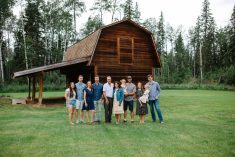It was 1985 and Jerry Lorenzen wondered whether what he was looking at was an opportunity. Lorenzen was working as an animal feed salesperson in the U.S. Midwest, so every day he was driving past crops that were getting grown to feed livestock. And he had a question. With spiralling population growth, won’t we need to feed those crops to people?
But Lorenzen also knew farming. Many feed crops aren’t so great for people, but they are great in the field. They’re what farmers need in a crop … rugged, high yielding, reliable.
So Lorenzen began to dream. Could he build a business by better adapting feed crops to people?
Read Also

Farmland values: assumptions and realities
Where farmland values are headed and what decisions farmers should make
He also began to work, drawing on the genetics work he had done during his college years to develop soybean varieties first in the basement, then the garden and eventually in the corner of a farm field.
But this, it turned out, was only one step in his eventual business formula.
1. Commit to the idea
“That was his hobby, he would breed soybeans,” says Lorenzen’s daughter, Nicole Atchison, who is today’s CEO of PURIS Holdings.
Eventually, his hobby became more time-consuming and he had to make a choice between staying on as an animal feed salesman versus going full-time into plant breeding. It wasn’t much of a contest.
“He chose to make the leap,” Atchison says. His goal was clear: to produce high-protein beans that are palatable to people.
It was the birth of a company, even if, at first, Lorenzen’s ideas weren’t well received.
“People thought, why are you doing this, this is such a small market, no one really cares,” Atchison says. “So he had to build the market too.”

The vision from the very start was to build a vertically integrated, plant-based food company, and Lorenzen concentrated on growing towards it slowly and carefully.
“We didn’t come out of the gate doing all the things we do today, but the vision was there,” Atchison says.
Lorenzen opened his first large-scale soybean conditioning facility in Oskaloosa, Iowa, in 1999, with a second plant in Randolph, Minnesota, in 2008.
Also in the early 2000s, Lorenzen’s company, World Food Processing, identified yellow field peas as a crucial link in the food chain. He saw them as a rotational crop that could increase farmers’ productivity via the opportunity to double crop them with other traditional crops like corn or wheat. The company continued to develop and patent a number of nutrient-rich pulses adapted for different growing conditions.
“My father invested in the processing capability so he could sell seed, and then he started selling seed to farmers, and then he built a facility so he could buy it back, process it, clean and sell it to food companies,” Atchison says. “Building this vertically integrated system was the model for the first and second decades.”
2. Get each step right
In 2011, Lorenzen bought a soy protein isolate facility in Turtle Lake, Wisconsin, which gave him the final piece of the puzzle: the ability to actually produce food ingredients.
Atchison calls it the next step up the value chain, making it possible to brand their non-GMO and organic soy protein isolate. “I guess the moral of the story is, it wasn’t an overnight thing. We slowly built the pieces together, establishing the foundation of the previous link in the chain before taking the risky leap to go into the next process because it required investing in capital.”
The real vision driving Lorenzen, and by now the whole family, was to create and build demand for the products they produced and also have control of the supply chain, so they could control the scale and make sure growth was sustainable.
3. Find your chance to get ahead of the curve
By 2014, the company had rebranded to PURIS and Jerry’s son, Tyler as vice-president, had spearheaded the commercial development of a new pea protein called PURISpea. Thus began the journey into developing some unique, differentiated products that would help the company create and pursue new market opportunities.
“We were selling soy protein isolate, and breeding peas on the side and struggling to compete with some of the really big established players,” Atchison says. “So, we made the move to pea protein because it was something unique and differentiated where, if we could have a quality product, it could stand out.”
At the time, there were a couple of companies making pea protein in Canada, but most of it was coming from China and because the quality was not high, it mostly ended up in pet food.
“We were able to show the market that you can actually make a great-tasting product,” Atchison said. “We developed the product markets first and then we built the supply chain to match.”
It’s what PURIS is good at — taking a measured approach to growth by coming up with some unique products.
“A differentiated product can stand out and give you some grace while you’re learning all the rest of the pieces,” Atchison says.
“Because as everyone who’s in the supply chain knows, even before the last couple of years, it is hard to scale things up. As soon as you have it scaled up and have a plant, you want it full, but you can’t build demand until you have a plant and it’s a weird catch-22 of how do you build demand without an asset, then once you have an asset you have got to sell the product.”
Over the years, through trial and error, PURIS has learned how to strike the balance, but Atchison admits that it takes time and patience to do that.
“If you can’t strike that balance, it’s really hard to make a profit,” says Atchison. “What we had the ability to do was navigate that journey slow and steady in the early years so that we could establish our base and our footprint before taking the huge leaps.”
They have also always been ahead of the market. “Plant-based food is no longer this odd thing,” Atchison says. “People are starting to appreciate it, be curious about it and in the last few years it’s gained a ton of momentum … we can leverage these market forces now to further propel our mission forward.”

4. Build farm loyalty
All along, a big part of their business model has been to excel at building relationships with growers and to ensure that when they come onboard, farmers are happy and stay for the long term.
That isn’t easy, especially perhaps because it’s an area where others in different industries have failed, making a lot of farmers understandably hesitant to jump into growing specialty crops that are supposed to be the next big thing.
“We understand that if you want to have a new specialty crop, and you want a farmer to grow it, a few things have to be true,” Atchison says. Farmers need an opportunity to assess the market, they’ve got to know there’s a buyer, and they’ve got to be able to evaluate their risks. “We handle that by doing full production contracts with acts of God clauses,” Atchison says. “When a grower works with us, they know that we’re buying all of their production — at what price — and it has an act of God clause in it, so it provides some level of assurance for them that they’re not going to have a crop in their bins with nowhere to go.”
Second, Atchison says, the crop has to yield well, because for most farmers, yield is still king.
“We’re commercializing new genetics and non-GMO food-grade crops,” she says. But their breeding programs are also focused on yield as well as disease and heat resistance, all of the things that are front and centre today. “Where other companies have done a lot of work on genetics in the traited commodities, less has been done in some of these specialty crops, so we’ve done that internally.”
PURIS has a large portfolio of crops with various levels of maturity groups and is always working with growers on the biggest challenges they have.
“Whether it’s white mould, or heat or shattering, we are working to try and bring those traits in so that we can address those issues for our growers,” Atchison says. “We can have the highest protein pea in the world, but if it doesn’t yield, our growers will not grow it so we’ve got to make sure that it performs in the field.”
And on top of all that comes constant communication with the growers and making sure they feel they are along on the journey as well.
“This is the hardest part because even for us scaling up the supply chain is not easy,” Atchison says. “When someone is building plants, the timing of those turning on is not easy to predict, so we try to shed a little bit of light on what’s going on in the market, so that there’s a connectivity, not just to the grain in the bin but also to where’s that going and why a little patience is warranted on some occasions.”
5. Go creative with your offer
A big challenge for PURIS has been the fact that their specialty crops still have to compete with established commodity crops like corn and soybeans. It’s an issue that has been amplified this year by grain shortages because of the crisis in Ukraine and Russia and other factors like drought.
“Sometimes specialty is very promising and can really drive returns for the bottom line, but in markets like this, they are not as attractive because there are record prices on your conventional commodities that have very simple supply chains,” Atchison says.
So, PURIS is taking the approach that they need to think more creatively to add value to growers’ rotations and not just try to compete with their primary cash crops. Again, they have turned to genetics to do that and ensure that their supply chain remains strong.
For instance, they’re focusing more on using peas in double-crop situations, so growers don’t have to choose not to grow corn, Atchison says. “If you can talk about growing peas and corn, that’s more interesting.”
They are also much more open to offering different types of contracts to growers this year.
“With some growers hesitant to commit to contracts because they’re bullish on pricing, that’s changed our model a bit,” Atchison says. “We’re more open to doing different types of contracting with the growers, whether it be open contracts or contracting after planting, which hasn’t always been part of our recipe, but it’s part of the requirement this year.”
The company is also looking to expand its sourcing footprint for organic and non-GMO crops into areas like Canada. The company already contracts with some growers in southeast Saskatchewan and southwest Manitoba, and has a delivery point in South Dakota.
“We are open to working with growers in, say, Canada and that supports some of our longer-term strategies of how we can diversify the growing regions,” Atchison says. “Those are longer-term strategies that we are actively pursuing.”
6. Never stop innovating
North America is one of the world’s largest producers of peas. Canada produces over four million acres and the U.S. just over one million. But last year’s serious drought in the U.S. meant that it became a net importer of peas. It’s another lesson learned: don’t sit back and take things for granted.
“It is easy to think it’s all good, but we are part of a global supply chain and last year’s drought really put that on showcase,” Atchison says. “For us, it’s put us more in touch with what’s going on globally and understanding all the different dynamics.”
Another vital aspect of the PURIS model is designing products with the customer in mind, looking at their challenges and how those problems can be solved through ingredient innovation.
A good example is a new product the company recently launched called pea syrup, which uses pea starch as an alternative sweetener to tapioca and corn starch.
“There’s a huge use of tapioca syrup up here in North America and that’s an imported product,” Atchison says. “Pea syrup can function and taste similarly, and can be a replacement but it’s also got a wonderful sustainability story, it’s got a local supply chain footprint and it’s an upcycled product. If you can replace an imported product with a domestic product that checks all the same boxes, that’s usually a win.”
7. Create more value
At the same time, they are also thinking of the farmers who will grow their products in terms of how they can create more value from a crop because there is no hard and fast rule when it comes to pricing premiums for farmers. In the final analysis, pricing signals are affected by the same factors as commodities: world markets, location, freight costs, weather and many other challenges.
“It’s not as easy as saying, here is what the value is, because if a product is overpriced, the value is displaced and that’s a hard thing to build a business model around,” Atchison says. “The price has to be competitive, otherwise the product doesn’t work long-term and the whole thing doesn’t scale.”
It’s often that exchange of value that is the trickiest thing to navigate, Atchison admits, because the farmer wants value, and at the same time there is a lot of risk and expense involved in building supply chain.
“When the markets are going down, it’s a valuable contract because we can lock in our prices, and pay what it is,” Atchison says. “When the markets are going up, the growers see that as less valuable because they’re typically bullish that they’re going to get more somewhere else. At some point the scales tip and behaviour changes, so our goal is to be steady and calm in the storm, and our practices are our practices and we try to adhere to that.”
8. Build a future you can believe in
“What really excites us is that fundamentally our system is built off of crops that are inherently good,” Atchison says. “We can lower our footprint related to international shipping and tell that story as we grow the plant-based market.”
There are other good-news stories too.Legumes in crop production provide benefits both at the production level and also on the nutritional and health sides, so the company can inspire itself, its partners and its customers with the message that going plant-based is good for them and good for the planet.
True to form, PURIS is taking a measured approach to exploiting ways to increase those values, whether through traceability or making specific environmental claims.
“There’s a lot of great ideas and a lot of smart people that are bringing tools to the equation,” Atchison says. “But the company’s reputation depends on whether partners such as growers actually see the benefits and feel they have a stake in the outcome.”
The PURIS team believes that if the world wants to feed itself sustainably, it must grow and consume more plant-based foods, and it must do it soon.
“We have to,” Atchison says. “If we want to make more food without converting more forested land to row-crop land, we need to use the acres that we have more productively and that means continuing to increase productivity, and diversification so that we have resilience from pests and other issues and find creative ways that we can use the land without being extractive.”
“If we can figure all those things out, we can set up a future for our great-great-grandkids that we’re proud of.”
















